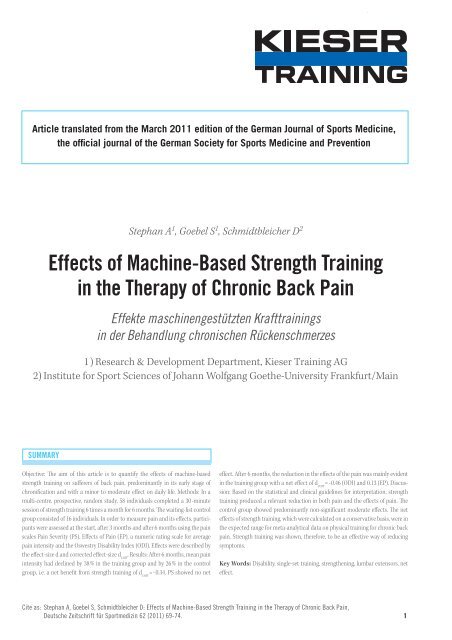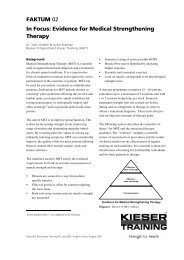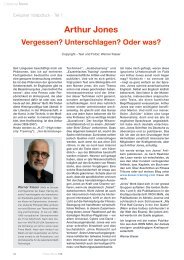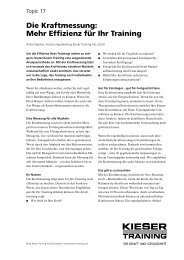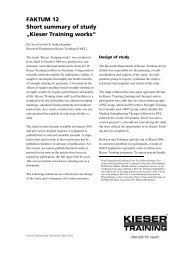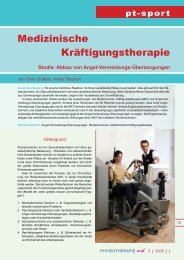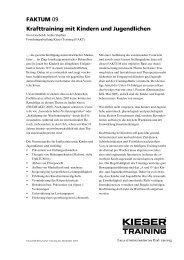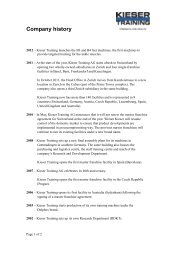Study: Strength training for chronic back pain - Kieser Training
Study: Strength training for chronic back pain - Kieser Training
Study: Strength training for chronic back pain - Kieser Training
Create successful ePaper yourself
Turn your PDF publications into a flip-book with our unique Google optimized e-Paper software.
Article translated from the March 2011 edition of the German Journal of Sports Medicine,<br />
the official journal of the German Society <strong>for</strong> Sports Medicine and Prevention<br />
SummAry<br />
Objective: The aim of this article is to quantify the effects of machine-based<br />
strength <strong>training</strong> on sufferers of <strong>back</strong> <strong>pain</strong>, predominantly in its early stage of<br />
chronification and with a minor to moderate effect on daily life. Methods: In a<br />
multi-centre, prospective, random study, 58 individuals completed a 30 -minute<br />
session of strength <strong>training</strong> 6 times a month <strong>for</strong> 6 months. The waiting-list control<br />
group consisted of 16 individuals. In order to measure <strong>pain</strong> and its effects, participants<br />
were assessed at the start, after 3 months and after 6 months using the <strong>pain</strong><br />
scales Pain Severity (PS), Effects of Pain (EP), a numeric rating scale <strong>for</strong> average<br />
<strong>pain</strong> intensity and the Oswestry Disability Index (ODI). Effects were described by<br />
the effect-size d and corrected effect-size d corr . Results: After 6 months, mean <strong>pain</strong><br />
intensity had declined by 38 % in the <strong>training</strong> group and by 26 % in the control<br />
group, i.e. a net benefit from strength <strong>training</strong> of d corr = - 0.34. PS showed no net<br />
Stephan A 1 , Goebel S 1 , Schmidtbleicher D 2<br />
Effects of machine-Based <strong>Strength</strong> <strong>Training</strong><br />
in the Therapy of Chronic Back Pain<br />
Effekte maschinengestützten Kraft<strong>training</strong>s<br />
in der Behandlung chronischen Rückenschmerzes<br />
1) Research & Development Department, <strong>Kieser</strong> <strong>Training</strong> AG<br />
2) Institute <strong>for</strong> Sport Sciences of Johann Wolfgang Goethe-University Frankfurt/Main<br />
effect. After 6 months, the reduction in the effects of the <strong>pain</strong> was mainly evident<br />
in the <strong>training</strong> group with a net effect of d corr = - 0.46 (ODI) and 0.13 (EP). Discussion:<br />
Based on the statistical and clinical guidelines <strong>for</strong> interpretation, strength<br />
<strong>training</strong> produced a relevant reduction in both <strong>pain</strong> and the effects of <strong>pain</strong>. The<br />
control group showed predominantly non-significant moderate effects. The net<br />
effects of strength <strong>training</strong>, which were calculated on a conservative basis, were in<br />
the expected range <strong>for</strong> meta-analytical data on physical <strong>training</strong> <strong>for</strong> <strong>chronic</strong> <strong>back</strong><br />
<strong>pain</strong>. <strong>Strength</strong> <strong>training</strong> was shown, there<strong>for</strong>e, to be an effective way of reducing<br />
symptoms.<br />
Key Words: Disability, single-set <strong>training</strong>, strengthening, lumbar extensors, net<br />
effect.<br />
Cite as: Stephan A, Goebel S, Schmidtbleicher D: Effects of Machine-Based <strong>Strength</strong> <strong>Training</strong> in the Therapy of Chronic Back Pain,<br />
Deutsche Zeitschrift für Sportmedizin 62 (2011) 69-74.<br />
1
2<br />
OrIGINALIA STrENGTh TrAINING fOr ChrONIC BACk PAIN<br />
INTrODuCTION<br />
PROBLEM AND AIM<br />
This article looks at the effect of a 6-month programme of independent<br />
machine-based strength <strong>training</strong> on individuals with <strong>back</strong><br />
<strong>pain</strong> in the early stage of chronification as compared with a control<br />
group on a waiting list. It is assumed that intervention reduces the<br />
level of <strong>pain</strong> experienced and its effects.<br />
Episodes of mild or moderate <strong>pain</strong> in the early stage of chronification<br />
often ease without treatment. Existing data shows that this<br />
can be up to 20% within 6 months [12]. To ensure that this factor is<br />
reflected in the evaluation of an intervention, the net effect is calculated<br />
(the difference between the effect of the intervention and the<br />
changes in control group).<br />
The bio-psychosocial explanatory model <strong>for</strong> <strong>back</strong> <strong>pain</strong> has<br />
gained general acceptance, i.e. the potential triggers or risk factors<br />
are not only biological in origin but psychological and social factors<br />
also play a role. Pfingsten has stated: “In most cases of prolonged<br />
<strong>back</strong> <strong>pain</strong>, although the origin could be traced <strong>back</strong> to an existing<br />
physical process (e.g. muscular dysfunction), the physical origin<br />
quickly lost its significance and was replaced by psychological factors<br />
in which cognitive beliefs and their associated effect on behaviour<br />
become paramount” [14, p. 84 1 ]. In the longer term, the anxiety<br />
surrounding physical exertion and the resultant physical inactivity<br />
cause a deconditioning of the muscles. Following an analysis of<br />
the main functional muscles in the trunk and neck, Denner found<br />
that patients with <strong>back</strong> <strong>pain</strong> had poor levels of strength and per<strong>for</strong>mance<br />
[2]. The current treatment <strong>for</strong> patients with <strong>chronic</strong> <strong>back</strong><br />
<strong>pain</strong> is designed to restore function, reduce the effects of <strong>pain</strong> and<br />
the anxiety associated with certain movements, control <strong>pain</strong> and<br />
overcome physical inactivity.<br />
Physical <strong>training</strong> offers the potential to achieve the above treatment<br />
aims. Most randomised, controlled studies in this field have<br />
been carried out on patients with <strong>chronic</strong> lumbar<br />
<strong>pain</strong>. Reviews show that physical <strong>training</strong> is<br />
at least as beneficial in terms of effectiveness as<br />
conservative treatments [9]. The studies that have<br />
produced superior results primarily included exercises<br />
to strengthen muscles and stabilise the<br />
trunk [9].<br />
mEThODOLOGy<br />
The data was generated during a multi-centre study<br />
between April and October 2009 with a group<br />
of volunteers displaying differing states of health.<br />
The study was conducted in the strength-<strong>training</strong><br />
facilities of an international provider of strength<br />
<strong>training</strong>.<br />
Design and Procedure<br />
Participants were recruited via the media from<br />
members of the adult German population. The intervention<br />
lasted 6 months. All participants were<br />
provided with written in<strong>for</strong>mation on the aims<br />
of the study and consented in writing to their<br />
participation. In order to achieve greater representation,<br />
the study was conducted at multiple<br />
1 translated by author<br />
centres. Diagram 1 shows the procedure adopted starting with the<br />
procedure to draw lots in order to select participants through to the<br />
random sampling procedure used <strong>for</strong> the sub-study “Chronic Back<br />
Pain”, which is the subject of this article.<br />
Inclusion criteria:<br />
• Back <strong>pain</strong> <strong>for</strong> more than 12 weeks or a minimum of two<br />
recurring episodes of <strong>pain</strong> each year <strong>for</strong> at least 2 years<br />
• Chronification stage 1 or 2 [7]<br />
• Able to do independent strength <strong>training</strong> following an<br />
assessment by the doctor<br />
Exclusion criteria:<br />
• Known osteoporosis<br />
• Non-stabilised cardio-vascular disorder, acute injury or<br />
inflammation affecting the musculoskeletal system, motor<br />
disorder, state post surgery<br />
• Current or previous customer of the provider<br />
Data was collected at the start of the study, after 3 months and after 6<br />
months. In order to ensure a standard methodology <strong>for</strong> both <strong>training</strong><br />
and data collection, all trainers and doctors involved in the study were<br />
given identical <strong>training</strong>. All facilities had identical <strong>training</strong> equipment<br />
and the <strong>training</strong> programmes and load norms used were the subject<br />
of binding rules.<br />
Participants<br />
Table 1 describes the sample and the characteristics of the sample<br />
group at the start of the intervention (no significant differences). Most<br />
of the participants had <strong>back</strong> <strong>pain</strong> in Stage 1 of chronification and moderate<br />
levels of <strong>pain</strong>. Individual diagnoses were not divulged to the<br />
study, which was only in<strong>for</strong>med of the symptoms as shown in Table<br />
1. Almost all participants reported lumbar <strong>pain</strong> in the last month.<br />
Diagram 1: Flow Chart <strong>for</strong> randomisation and sampling procedure
Table 1: Sampling characteristics<br />
Radiating <strong>pain</strong> and sensory disorders were rare. Physical deconditioning,<br />
as measured by the strength of lumbar extensors, had not yet<br />
advanced significantly compared with those without <strong>back</strong> problems.<br />
The effects of the <strong>back</strong> <strong>pain</strong> and the reduction in function were slight<br />
to moderate.<br />
Intervention<br />
The <strong>training</strong> group completed progressive hypertrophy-oriented<br />
strength <strong>training</strong> on <strong>training</strong> machines with a variable resistance.<br />
The aim was to improve the function and structure of muscles,<br />
particularly the trunk muscles. The programme included lumbarextensor<br />
<strong>training</strong> with the pelvis stabilised (Diagram 2). Participants<br />
received a personal induction by qualified staff during the first<br />
three <strong>training</strong> sessions. An individual check session was provided<br />
at the 10 th session and then every 20 th session and if necessary an<br />
individual’s <strong>training</strong> programme was modified. The <strong>training</strong> programme<br />
covered all muscle groups in the body. Table 2 shows the<br />
load norms used during the strength <strong>training</strong>.<br />
The control group received no <strong>training</strong> during the intervention<br />
period. However, they were given the opportunity subsequently to<br />
train <strong>for</strong> 6 months free of charge (waiting list control group).<br />
Measuring systems<br />
To determine the <strong>pain</strong> experienced in the last 4 weeks, the study<br />
used two <strong>pain</strong> scales from the Medical Outcomes <strong>Study</strong> (MOS)<br />
and the Oswestry Disability Index (ODI) (10, 3). For this purpose,<br />
participants were asked to complete a written questionnaire.<br />
In addition, the maximum strength of the lumbar extensors was<br />
measured.<br />
STrENGTh TrAINING fOr ChrONIC BACk PAIN<br />
<strong>Training</strong> group (n=58) Control group (n=16)<br />
Percentage<br />
in group (%) mean ±SD<br />
95% Confidence<br />
interval<br />
Percentage – female 53.4% 62.5%<br />
Percentage<br />
in group (%) mean ±SD<br />
OrIGINALIA<br />
95% Confidence<br />
interval<br />
Age (years) 44.37 ±15.20 [40.59;48.65] 44.88 ±13.56 [37.65;52.10]<br />
Height (cm) 174.52 ±10.22 [171.70;177.06] 170.41 ±10.43 [164.85;175.97]<br />
Weight (kg) 75.39 ±15.97 [70.90;79.39] 71.63 ±15.02 [63.62;79.63]<br />
Predominantly sedentary activity 56.9% 62.5%<br />
No sport 34.5% 43.8%<br />
Experience of strength <strong>training</strong> 27.6% 12.5%<br />
Pain in lumbar/thoracic/cervical spine (multiple<br />
answers)<br />
96.9% / 5.2% / 22.4% 93.8% / 12.5% / 37.5%<br />
Chronification Stage I / II (7) 87.9% / 12.1% 75% / 25%<br />
Radicular radiation 5.2% 18.8%<br />
Pseudo-radicular radiation 12.1% 18.8%<br />
Perception disorder 0% 18.8%<br />
Intensity of <strong>pain</strong> in last 4 weeks (0-100) 25.78 ±13.6 [22.20;29.35] 21.56 ±7.24 [17.71;25.42]<br />
Pain Severity (PS, 0-100) 56.03 ±13.58 [52.46;59.60] 57.00 ±14.65 [49.20;64.80]<br />
Effects of Pain (EP, 0-100) 73.43 ±22.54 [67.51;79.36] 71.61 ±15.75 [63.22;80.01]<br />
Oswestry Disability Index (ODI, 0-100) 10.37 ±9.66 [7.83;12.91] 9.03 ±7.32 [5.13;12.94]<br />
Lumbar extension strength (Nm) 222.80 ±103.11 [192.65;249.05] 207.94 ±84.35 [161.23;254.65]<br />
% with significant strength deficit (PR
OrIGINALIA STrENGTh TrAINING fOr ChrONIC BACk PAIN<br />
Statistical procedures<br />
For data evaluation, the software SPSS Statistics 17.0 was used. As<br />
some variables have no normal distribution (Shapiro Wilk Test), we<br />
used the Wilcoxon non-parametric signed-rank test to verify differences<br />
between paired means and <strong>for</strong> non-paired means, we used<br />
the U test of Mann Whitney. To verify the statistical significance,<br />
the significance level was set at = 5%. With a sample of this<br />
size, effects are verifiable from d 0.37 <strong>for</strong> the <strong>training</strong> group and<br />
d 0.75 <strong>for</strong> the control group (power of test = 0.8). To evaluate the<br />
practical significance of differences, we calculated the effect sizes<br />
d and the corrected effect sizes d corr [11]; the latter reflected group<br />
differences in the pre-test and the sample size.<br />
rESuLTS<br />
Erector muscle of spine<br />
m. erector spinae<br />
Diagram 2: Exercise Machine <strong>for</strong> lumbar extension: as pelvis is immobilised,<br />
lumbar extensors are the target muscles<br />
Participants trained on average <strong>for</strong> 24.5 (±2.0) weeks. They trained<br />
1.6 times (±0.4) per week (min: 0.7; max: 2.4). At the end of the<br />
intervention, 20 of those in the <strong>training</strong> group were completely<br />
free from <strong>pain</strong>, of which 9 had previously had moderate/strong<br />
<strong>pain</strong> and 11 slight/very slight <strong>pain</strong>. In the control group, 6 were<br />
completely free from <strong>pain</strong>, of which 3 had previously reported very<br />
slight and 3 moderate <strong>pain</strong>. None of this group had undergone any<br />
medical treatment during the intervention period. Table 3 provides<br />
a summary of the results of the two repeat tests. The statistical<br />
tests and the effect sizes relate to the start date. Diagram 3 shows<br />
the percentage change in outcome parameters.<br />
Severity of <strong>back</strong> <strong>pain</strong><br />
For groups with lower baseline scores <strong>for</strong> <strong>pain</strong>, a change of 30%<br />
is classed as clinically important [4]. The <strong>training</strong> group achieved<br />
this change in both severity criteria after 3 months; the control<br />
group achieved it in the PS scale after 6 months. The corrected<br />
effect sizes <strong>for</strong> PS after 3 months and 6 months were d corr =0.3 and<br />
0.08. In both groups, the improvement in PS was comparable at the<br />
Table 2: Standard load norms <strong>for</strong> strength <strong>training</strong><br />
Number of <strong>training</strong> sessions 1.6 times per week<br />
Duration of <strong>training</strong> 24.5 weeks<br />
Exercises Programme <strong>for</strong> complete body consisting of<br />
10 exercises on machines (incl. lumbar extensors,<br />
hip/abdominal/leg/<strong>back</strong>/shoulder muscles)<br />
Order of exercises Large muscle groups be<strong>for</strong>e small ones, “problem<br />
exercises” earlier in the programme<br />
Load magnitude Approx. 60% of dynamic maximum strength<br />
(1 repetition maximum)<br />
Number of repetitions/sets 6-9 / 1<br />
Duration of each contraction type<br />
per repetition<br />
4 seconds concentric, 2 seconds isometric, 4 seconds<br />
eccentric<br />
Time under load <strong>Training</strong> sessions 1-20: 60-120 sec, from <strong>training</strong><br />
session 21: 60-90 sec.<br />
muscle fatigue <strong>Training</strong> sessions 1-20: sub-maximal number of<br />
repetitions to repetition maximum<br />
From <strong>training</strong> session 21: repetition maximum to<br />
point of temporary muscle fatigue<br />
range of motion Individual maximum (<strong>pain</strong>-free) possible movement<br />
of joint<br />
recovery time between <strong>training</strong><br />
sessions<br />
At least 48 hours<br />
end of the 6 months but in the <strong>training</strong> group, the improvement<br />
took place earlier.<br />
Treated as an individual criterion, average <strong>pain</strong> intensity in<br />
the last 4 weeks of the 6-month period declined in the <strong>training</strong><br />
group by 11.2 (±16.55, d=-0.55) points and in the control group<br />
by 6.87 (±17.4, d=-0.33) points. This corresponds to a relative reduction<br />
in the <strong>pain</strong> compared with start levels of 38.2% or 25.6%.<br />
This means that the reduction in average <strong>pain</strong> intensity can only<br />
be regarded as clinically important in the <strong>training</strong> group. The net<br />
effect of the strength <strong>training</strong> was d corr =-0.42 after 3 months and<br />
d corr =-0.34 after 6 months (= 4.33 points). This is within the expected<br />
range <strong>for</strong> the net effect of physical <strong>training</strong> <strong>for</strong> 6 months<br />
by patients with <strong>chronic</strong> <strong>back</strong> <strong>pain</strong> calculated from meta-analytical<br />
data and compared with no intervention (confidence interval<br />
there: 1.31-19.09) [9].<br />
Effect of <strong>back</strong> <strong>pain</strong><br />
One of the recommendations <strong>for</strong> the interpretation of measures of<br />
quality of life – which includes EP and in its wider sense ODI as<br />
well – is an evaluation of the effect size. With most test tools, a<br />
shift in the mean by half of one standard deviation (d=0.5) is regarded<br />
as clinically relevant [13]. Both groups achieved this in both<br />
criteria within 3 months although EP change was not significant in<br />
the control group. After 6 months, the <strong>training</strong> group had improved<br />
further in both criteria but the control group had not improved.<br />
The average individual improvement in EP was 13.99 ±27.93 points<br />
(31.8%) in the <strong>training</strong> group and 11.46 ±25.25 points (19.3%) in the<br />
control group. The corrected effect size <strong>for</strong> 3 and 6 months was<br />
d corr =0.13.<br />
After 6 months, the ODI in the <strong>training</strong> group declined<br />
by 6.45 ±10.48 points (58.5%) and in the control group by 2.07<br />
±8.67 points (36.2%). The corrected effect size at 6 months was<br />
d corr =-0.46 (= 4.38 points). This was also in the expected range<br />
of net effects calculated from meta-analytical data (confidence<br />
interval: -0.53-6.48 points) [9].<br />
4
Diagram 3: Percentage change in<br />
outcome parameters after 3 and<br />
6 months (*p
OrIGINALIA STrENGTh TrAINING fOr ChrONIC BACk PAIN<br />
Table 3: Results of repeat measurements<br />
3 months<br />
Intensity of <strong>pain</strong> in last 4<br />
weeks (0-100)<br />
and avoiding a recurrence. If there is a recurrence, the improved<br />
structural and functional quality of muscles means that function is<br />
likely to be restored more quickly.<br />
The time directly spent on <strong>training</strong> was only 3 hours per<br />
month; over the 6-month period, it was 18 hours. The independent<br />
machine-based <strong>training</strong> was well received by participants. The<br />
drop-out rate was 27%, which is less than the comparable figure<br />
from German fitness chains (35.3%) [1]. For those <strong>training</strong> at home,<br />
it is assumed that the drop-out rate would be significantly higher<br />
and the quality of the <strong>training</strong> insufficient [16].<br />
Anika Stephan and Dr. Sven Goebel work <strong>for</strong> the Research and<br />
Development Department at <strong>Kieser</strong> <strong>Training</strong> AG. Prof. Dr. Dietmar<br />
Schmidtbleicher has been remunerated <strong>for</strong> his consultancy by <strong>Kieser</strong><br />
<strong>Training</strong> AG.<br />
BIBLIOGrAPhy<br />
<strong>Training</strong> group (n=58) Control group (n=16)<br />
mean ±SD Confidence interval median Z D mean ±SD Confidence interval median Z d<br />
15 ±15.15 ** [10.98;19.02] 15 -4.132 -0.56 16.25 ±10.25 [10.79;21.71] 15 -1.427 -0.33<br />
Pain Severity (PS. 0-100) 72.68 ±20.28 ** [67.30;78.06] 71 -4.800 0.87 68.13 ±17.65 [58.72;77.53] 62 -1.863 0.69<br />
Effects of Pain (EP.<br />
0-100)<br />
Oswestry Disability Index<br />
(ODI. 0-100)<br />
6 months<br />
Intensity of <strong>pain</strong> in last 4<br />
weeks (0-100)<br />
86.42 ±15.64 ** [82.27;90.57] 91.7 -3.981 0.68 83.07 ±16.42 [74.32;91.82] 89.6 -1.907 0.71<br />
5.10 ±6.66 ** [3.33;6.87] 2 -4.642 -0.65 4.83 ±6.80 * [1.20;8.45] 2.1 -2.308 -0.60<br />
14.57 ±16.66 ** [10.19;18.95] 10 -4.449 -0.55 14.69 ±15.76 [6.29;23.08] 10 -1.576 -0.33<br />
Pain Severity (PS. 0-100) 75.71 ±23.03 ** [69.01;81.12] 76 -5.034 0.94 74.69 ±23.60 * [62.11;87.26] 73 -2.224 0.84<br />
Effects of Pain (EP.<br />
0-100)<br />
Oswestry Disability Index<br />
(ODI. 0-100)<br />
Lumbar extension<br />
strength (Nm)<br />
87.43 ±18.16 ** [82.65;92.20] 93.8 -3.595 0.69 83.07 ±26.50 [68.95;97.20] 95.8 -1.637 0.54<br />
4.10 ±7.98 ** [1.99;6.22] 0 -4.738 -0.71 6.97 ±12.45 [0.33;13.60] 1 -1.084 -0.21<br />
247.11 ±97.8 * [219.61;274.62] 211.89 -3.412 0.25 193.99 ±72.35 [145.38;242.59] 163.86 -0.622 0.04<br />
Wilcoxon non-parametric signed rank test as a comparison of start of intervention: ** p


